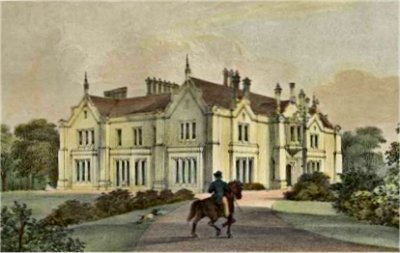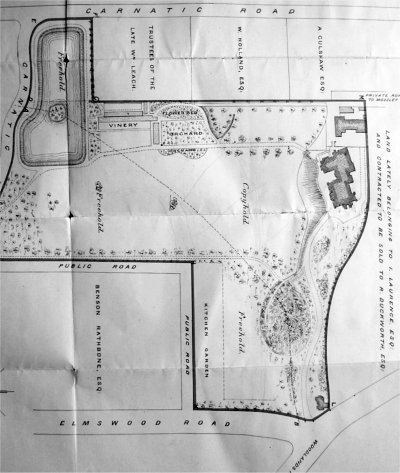| The area
around the presently named North Mossley Hill
Road has the greatest concentration of surviving
Victorian mansions. Nevertheless a number of
significant houses have disappeared. |
| On Mossley
Hill Road itself, Moreno House, opposite
Clearwood, has disappeared along with Carnatic
Hall and Elmswood Hall, under the
Liverpool University halls of residence, but
everything else is essentially intact apart from
altered usage. |
| Elmswood
Hall was a grand mansion on a 13˝ acre (5˝ ha)
site between Carnatic Road and Elmswood Road,
built before 1850. It was acquired in about 1860
by William Dawbarn (1819-1881), whose family were
in the drapery business in Wisbech,
Cambridgeshire. He relocated his large family of
eleven children to Liverpool, where he took over
his father-in-law’s slate business, which
ultimately became Dawbarn & Co., a supplier
of a broad range of building materials. The
success of his business in Liverpool led to his
involvement in local government and public
affairs. |
| Following
Dawbarn's death, the property was put up for
auction in 1884. The auction pamphlet provides a
wealth of detail, including photographs and a
map. The 'capital mansion' was to be sold with: |
| |
[..] land,
shrubberies, pleasure grounds, and outbuildings
thereto belonging, including vineries,
conservatory, pine and forcing houses, stabling
for eight horses, shippons for four cows, pigsty,
fowl pens, etc. The house is pleasantly situate
in its own grounds, which are beautifully wooded
and tastefully laid out, and contain an
ornamental dell or quarry and a small lake,
suitable for boating or fishing, and from its
elevated position commands very lovely views over
the River Mersey and the Cheshire and Welsh
ranges of hills. |
| This
provides a unique insight into the general style
of some of these more up-market Mossley Hill
properties when they were at their peak. From
c.1900 until its demolition c.1960, the Hall is
denoted on the Ordnance Survey maps as a laundry.
A possible explanation of this odd fact is that
it was at that time one of those institutions
run, like Kelton, by the Catholic Church as a
home for young single mothers and their children,
where the mothers had to work for their keep
under trying conditions in the laundry. |
| The houses
on Elmsley Road have by and large survived,
although Elmsley itself has gone under
an impressive modern house. On Park Road we still
have Mossley House, part of Mossley Hill
Hospital, but have lost Parkside. On
Carnatic Road, Redcourt survives. |
|
 |
| Elmswood
Hall in its Heyday |
 |
| Map
of Elmswood Hall in 1884 |
|
| Outside of this area,
the story is not so good. At the junction of
Mossley Hill road and Elmswood Road, two large
properties, Riversley and High
Pastures, both built before 1850, have
disappeared. In 1851 Riversley became the home of
Charles Pierre Melly (1829-1888), eldest son of
André Melly (1802-1851), born in Geneva. André
was famous for attempting, in 1850, to discover
the source of the River Nile. He reached Khartoum
with his wife, two sons and daughter (the first
time any European women had been there), but died
of fever near Berber in Sudan on the return. In
1851, Charles bought Riversley as a country
residence for the family. It remained in the
family until 1951, when, in a state of total
neglect, it was left to Liverpool University and
demolished. |
| André Melly's younger
son, George I (1830-1894) was a merchant,
shipowner and Liberal Member of Parliament. He
was the great-grandfather of George Melly II
(1926-2007), the famous jazz singer, writer and
art critic, especially on surrealism. As a
youngster, George II visited his relatives in
Riversley. He was a third cousin twice removed of
Emma Holt of nearby Sudley. His
great-grandfather George Melly I's wife Sarah
Bright had a sister Elizabeth, who married George
Holt, Emma's father. He visited Emma regularly in
Sudley in the 1930s. |
| Just down Elmswood Road
from Riversley stood Rosemont, another
substantial property dating from before 1850. In
1932 the zoo at Otterspool relocated there, much
to the displeasure of the Mossley Hill residents.
The throngs of visitors and the sound of lions
roaring at night did not meet with their
approval. The star attraction was a chimpanzee
called Mickey, whose party tricks included
blowing raspberries and playing football games
with the public. He escaped several times,
running rampant through the quiet streets and
over the rooftops and molesting passers-by. On
the last occasion in 1938 he was shot by an army
marksman and the zoo closed later that year. |
| In the wedge of Elmswood
Road and Woodlands Road was another group of
significant properties and just one, at the apex,
that is still there: The Mount with its
cottage. Further down Woodlands Road on the right
was Roselands, while along Elmswood Road
on the left were Beechlawn and Oakfield,
later called Oakwood. Opposite Oakfield
was the particularly large estate of Mossley
Bank. Roseland, Oakfield and Mossley Bank
predated 1850; the others were somewhat later. |
|